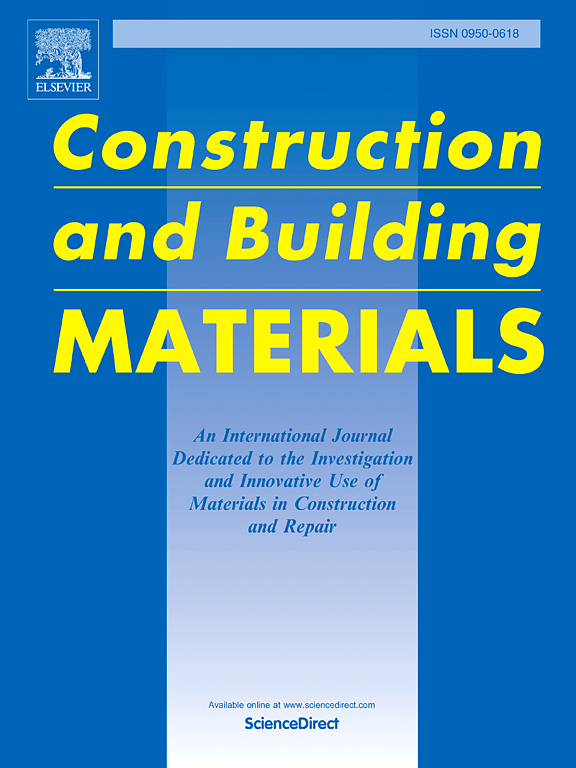Fatigue-induced degradation of self-healing properties of asphalt mixtures: Mechanisms and quantitative characterization
IF 7.4
1区 工程技术
Q1 CONSTRUCTION & BUILDING TECHNOLOGY
引用次数: 0
Abstract
Understanding how self-healing properties degrade during fatigue processes is crucial for improving the accuracy of fatigue life predictions in asphalt mixtures. This study refined the indirect tensile (IDT) fatigue test method and introduced a novel self-healing parameter E(n)Healing,F-H, derived from elastic modulus variations. The validity of the IDT fatigue-healing test was confirmed, and the effects of binder type, loading mode, and freeze-thaw cycles on E(n)Healing,F-H were systematically investigated. Results demonstrated that the IDT fatigue-healing test effectively quantified self-healing properties, revealing significantly extended fatigue life compared to conventional IDT fatigue tests. The E(n)Healing,F-H captured an exponential degradation of self-healing properties with accumulated fatigue damage. Notably, under high stress ratios, low frequencies, and multiple freeze-thaw cycles, E(n)Healing,F-H exhibited nearly linear and accelerated degradation with increasing fatigue cycles. However, extended load intervals and higher frequencies alleviated E(n)Healing,F-H degradation, whereas increased stress ratios and freeze-thaw cycles amplified it. To enhance the predictive accuracy of crack resistance performance, the E(n)Healing,F-H was integrated into the HMA-FM (Hot Mix Asphalt Fracture Mechanics) self-healing model. This integration corrected the overestimation of healing effects and provided a more comprehensive healing model.
沥青混合料疲劳诱导的自愈性能退化:机制和定量表征
了解自愈特性在疲劳过程中是如何退化的,对于提高沥青混合料疲劳寿命预测的准确性至关重要。该研究改进了间接拉伸(IDT)疲劳试验方法,并引入了一个新的自愈参数E(n)Healing,F-H,由弹性模量变化得出。验证了IDT疲劳愈合试验的有效性,系统研究了粘结剂类型、加载方式、冻融循环对E(n)愈合、f (h)愈合的影响。结果表明,与传统的IDT疲劳试验相比,IDT疲劳愈合试验有效地量化了自愈性能,显示了显著延长的疲劳寿命。E(n)愈合,F-H捕捉到随着疲劳损伤的累积,自愈性能呈指数级下降。值得注意的是,在高应力比、低频率和多次冻融循环下,随着疲劳循环次数的增加,E(n)愈合、F-H表现出近乎线性的加速退化。然而,延长的加载间隔和更高的频率减轻了E(n)愈合,f (h)退化,而增加的应力比和冻融循环则放大了它。为了提高抗裂性能的预测精度,将E(n)愈合,F-H集成到HMA-FM(热混合沥青断裂力学)自愈合模型中。这种整合纠正了对治疗效果的高估,并提供了一个更全面的治疗模型。
本文章由计算机程序翻译,如有差异,请以英文原文为准。
求助全文
约1分钟内获得全文
求助全文
来源期刊

Construction and Building Materials
工程技术-材料科学:综合
CiteScore
13.80
自引率
21.60%
发文量
3632
审稿时长
82 days
期刊介绍:
Construction and Building Materials offers an international platform for sharing innovative and original research and development in the realm of construction and building materials, along with their practical applications in new projects and repair practices. The journal publishes a diverse array of pioneering research and application papers, detailing laboratory investigations and, to a limited extent, numerical analyses or reports on full-scale projects. Multi-part papers are discouraged.
Additionally, Construction and Building Materials features comprehensive case studies and insightful review articles that contribute to new insights in the field. Our focus is on papers related to construction materials, excluding those on structural engineering, geotechnics, and unbound highway layers. Covered materials and technologies encompass cement, concrete reinforcement, bricks and mortars, additives, corrosion technology, ceramics, timber, steel, polymers, glass fibers, recycled materials, bamboo, rammed earth, non-conventional building materials, bituminous materials, and applications in railway materials.
 求助内容:
求助内容: 应助结果提醒方式:
应助结果提醒方式:


